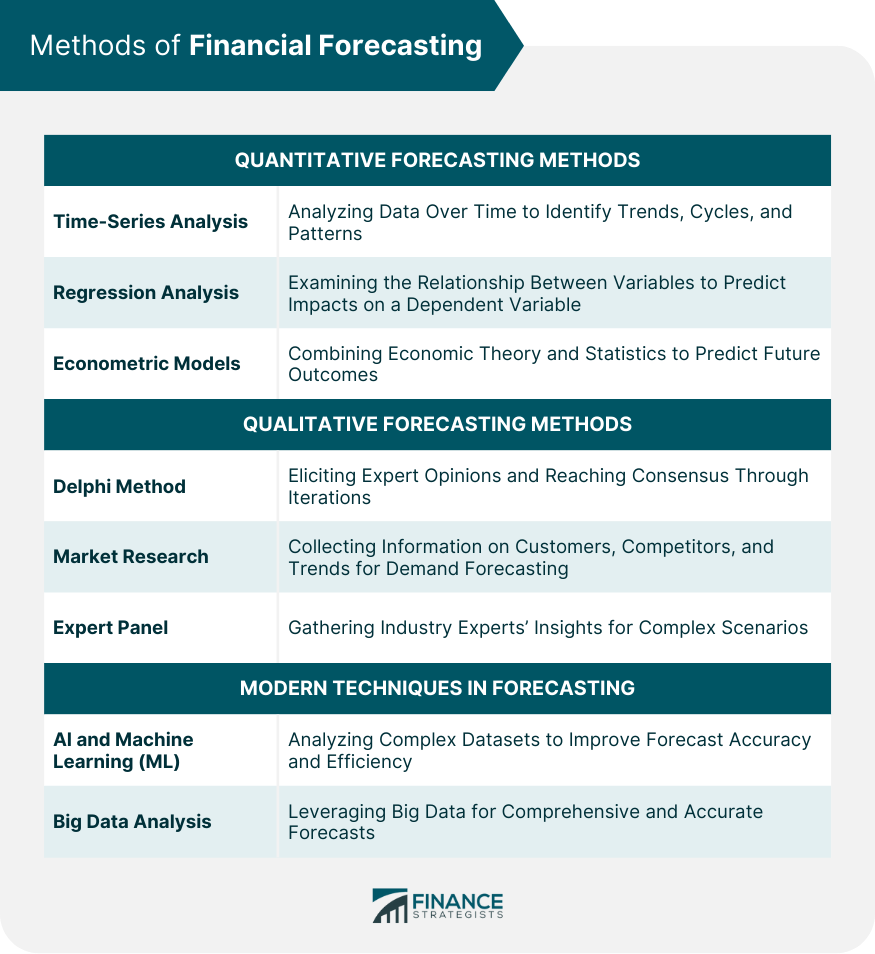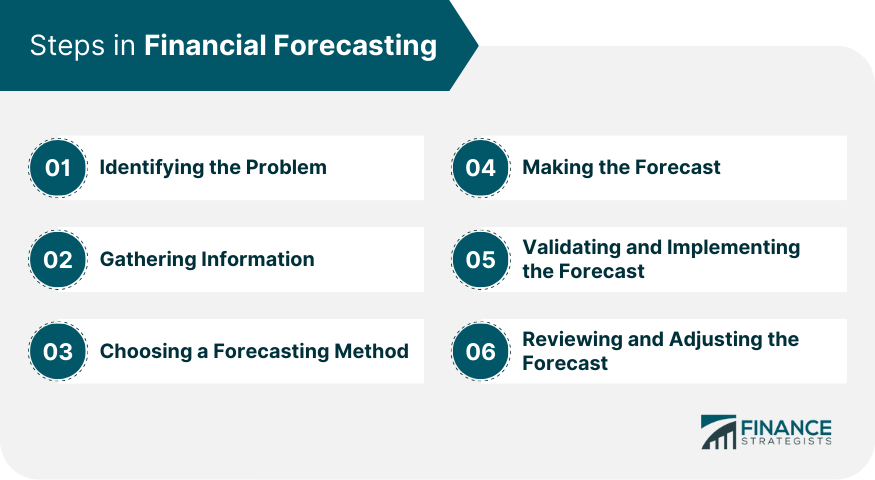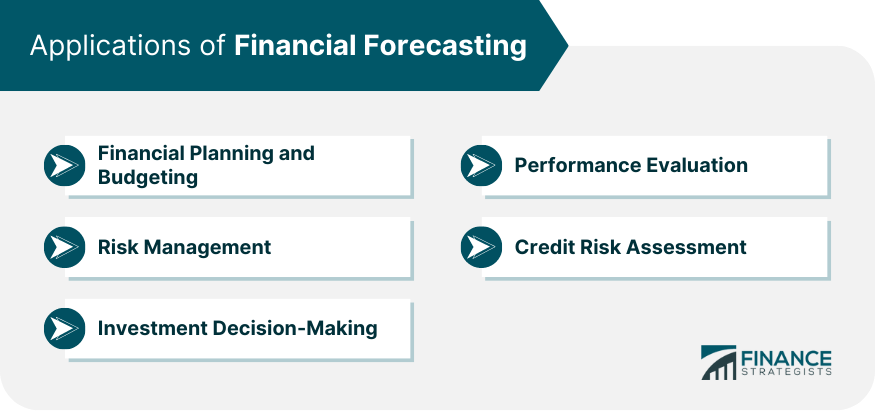Financial forecasting is the act of estimating future financial outcomes for a business or an investment. It is a critical process in financial planning and decision-making. It employs statistical tools and methodologies, leveraging historical data and current market trends to predict future financial trends and events. Forecasting serves as a vital tool for businesses and investors, offering insights that aid in making informed strategic decisions. These insights can span a range of areas, including budgeting, risk management, investment planning, and performance analysis. It also plays a pivotal role in helping organizations mitigate potential financial risks by preparing for various financial scenarios. Furthermore, financial forecasting is instrumental in guiding corporate growth strategies and providing stakeholders with a clear outlook of a company's financial future. Several key financial concepts underpin forecasting. These include revenue, which is the income a business earns from its operations; expenses, the costs incurred in generating revenue; cash flows, the money moving in and out of the business; and profitability, the financial gain or loss realized by a business over a period. Understanding these elements allows for a more accurate and insightful forecast. Variability and trends are two crucial aspects of financial forecasting. Variability refers to the degree of fluctuation in data over time, impacting the accuracy of predictions. Trends, on the other hand, represent a consistent directional movement in data. Recognizing these patterns can help forecasters anticipate future movements, thus improving the forecasting model's precision. Seasonality can significantly influence forecasting. Many businesses experience seasonal sales cycles, with periods of high and low demand throughout the year. By recognizing these seasonal trends, businesses can adjust their operational and marketing strategies accordingly, allowing for better resource allocation and enhanced profitability. Similar to seasonality, cyclical patterns can also affect forecasts. These patterns are recurrent but do not follow a fixed calendar-based timing, often occurring due to broader economic or industry cycles. By identifying and understanding these cycles, businesses can prepare for potential downturns and capitalize on growth phases. Time-series analysis involves analyzing data collected over time to identify trends, cycles, and seasonal patterns. This method allows for the prediction of future values based on previously observed values. For instance, a company could use time-series analysis to forecast future sales based on past sales data. Regression analysis is a statistical method used to examine the relationship between two or more variables. In finance, it might be used to investigate how changes in the independent variable(s) (e.g., interest rates or economic indicators) are expected to impact the dependent variable (e.g., a company's earnings). Econometric models are sophisticated tools used for financial forecasting. These models combine economic theory and statistical techniques to predict future economic and financial outcomes. For example, an econometric model could be used to forecast how changes in GDP or inflation rates will affect stock market performance. The Delphi Method is a forecasting technique that involves eliciting opinions from a panel of experts. The responses are aggregated, and the process is repeated until a consensus is reached. This method is useful when there is a lack of historical data or when the forecast involves a new product or service. Market research involves collecting information about customers, competitors, and market trends. It can include surveys, interviews, focus groups, and analysis of secondary data. This information can be used to forecast market demand, consumer preferences, and competitive dynamics. An expert panel involves gathering a group of individuals with specific expertise in a particular field or industry. The panel provides their insights and judgments, which are used to form a forecast. This method can be beneficial for complex scenarios that require a deep understanding of the subject matter. Artificial Intelligence (AI) and Machine Learning (ML) have brought about a significant shift in the financial forecasting landscape. These technologies enable the analysis of vast and complex datasets, improving the accuracy and efficiency of forecasts. For instance, ML algorithms can analyze historical financial data to detect patterns and predict future trends. The emergence of big data has revolutionized financial forecasting. Businesses can now analyze vast volumes of data from various sources, providing more comprehensive insights and more accurate forecasts. For instance, companies might analyze social media data to gauge consumer sentiment, which could influence demand forecasts. The initial step in financial forecasting involves identifying the specific financial problem or question. It could be forecasting sales revenues for the next quarter, projecting cash flows for the upcoming year, or estimating the potential return on an investment. After defining the problem, the next step is to collect relevant data. This data might include historical financial records, market trends, industry data, and economic indicators. The quality of the data gathered significantly influences the accuracy of the forecast. Choosing the right forecasting method depends on the problem at hand, the data available, and the required forecast horizon. The choice could be between quantitative methods like time-series analysis and regression models, or qualitative methods like expert panels and the Delphi method. Once the method is chosen, the actual forecasting process begins. This involves analyzing the data using the selected method and generating a forecast. This step might require the use of statistical software or financial modeling tools. The next step is to validate the forecast, checking it against historical data or using other validation methods to ensure its accuracy. Once validated, the forecast can be implemented into the financial planning or decision-making process. Finally, forecasts should be regularly reviewed and adjusted as necessary. This is because financial environments are dynamic, with various internal and external factors potentially impacting the forecast's accuracy. Financial forecasting plays a critical role in financial planning and budgeting, helping businesses project revenues, expenses, and profitability, facilitating effective resource allocation. In risk management, forecasting can help identify potential financial risks and uncertainties, allowing businesses to take preventive measures or develop contingency plans. Investors use financial forecasting to predict the future performance of potential investments, informing their decision-making process and helping them maximize returns. Forecasting can serve as a benchmark for performance evaluation, enabling businesses to compare projected outcomes against actual results, assess performance, and make necessary adjustments. In the context of lending, financial forecasting is used to assess credit risk by predicting a borrower's ability to repay a loan, thus influencing loan approval decisions and interest rate determinations. Financial forecasting's accuracy largely depends on the availability and quality of data. Inadequate or inaccurate data can lead to erroneous forecasts. Financial forecasts often rely on assumptions about the future. If these assumptions prove inaccurate, the forecast may also be incorrect. While forecasting models can be powerful tools, they have inherent limitations. For example, they often rely on historical data to predict the future, which may not always be indicative of future outcomes. Unexpected external factors like economic crises, policy changes, or natural disasters can significantly influence a forecast's accuracy, representing an inherent challenge in financial forecasting. Financial forecasting, a crucial process in financial management and decision-making, involves strategic estimations of future financial outcomes using statistical tools and methodologies. Key financial concepts such as revenues, expenses, cash flows, and profitability form the foundation for this forecasting. Methods range from traditional techniques like time-series analysis, regression models, and the Delphi method to modern Artificial Intelligence, Machine Learning, and Big Data techniques. The financial forecasting process follows a systematic sequence: identifying the problem, gathering information, selecting a method, making the forecast, validating and implementing it, and finally, reviewing and adjusting it. Its applications include financial planning, budgeting, risk management, investment decision-making, performance evaluation, and credit risk assessment. Forecasting accuracy can be impacted by data quality, assumption correctness, model limitations, and unforeseen external factors. Considering the complexity and significance of accurate financial forecasting, professional wealth management services can be invaluable, aiding in decision-making and effective financial planning.What Is Forecasting?
Key Concepts in Financial Forecasting
Overview of Key Financial Concepts
Understanding Variability and Trends
Impact of Seasonality in Forecasting
Role of Cyclical Patterns in Forecasting
Methods of Financial Forecasting
Quantitative Forecasting Methods
Time-Series Analysis
Regression Analysis
Econometric Models
Qualitative Forecasting Methods
Delphi Method
Market Research
Expert Panel
Modern Techniques in Forecasting
Artificial Intelligence and Machine Learning in Forecasting
Big Data Analysis in Forecasting

Steps in Financial Forecasting
Identifying the Problem
Gathering Information
Choosing a Forecasting Method
Making the Forecast
Validating and Implementing the Forecast
Reviewing and Adjusting the Forecast

Applications of Financial Forecasting
Financial Planning and Budgeting
Risk Management
Investment Decision-Making
Performance Evaluation
Credit Risk Assessment

Limitations and Challenges of Financial Forecasting
Data Availability and Quality
Assumption Accuracy
Limitations of Forecasting Models
Unexpected External Factors
Final Thoughts
Forecasting FAQs
Forecasting in finance is the process of predicting future financial outcomes, such as revenues, expenses, cash flows, or investment returns.
Forecasting is crucial in financial planning because it provides insights into future financial conditions, facilitating informed decision-making and effective resource allocation.
Financial forecasting uses both quantitative methods, like time-series analysis and regression models, and qualitative methods, such as the Delphi method and expert panels.
Limitations of financial forecasting include data availability and quality, assumption accuracy, limitations of forecasting models, and unexpected external factors.
Artificial intelligence is used in financial forecasting to analyze vast and complex datasets, detect patterns, and generate more accurate and efficient forecasts.
True Tamplin is a published author, public speaker, CEO of UpDigital, and founder of Finance Strategists.
True is a Certified Educator in Personal Finance (CEPF®), author of The Handy Financial Ratios Guide, a member of the Society for Advancing Business Editing and Writing, contributes to his financial education site, Finance Strategists, and has spoken to various financial communities such as the CFA Institute, as well as university students like his Alma mater, Biola University, where he received a bachelor of science in business and data analytics.
To learn more about True, visit his personal website or view his author profiles on Amazon, Nasdaq and Forbes.















